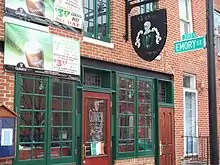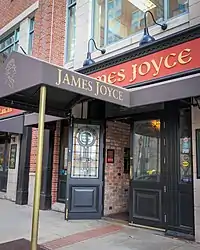History of the Irish in Baltimore
The history of the Irish in Baltimore dates back to the early and mid-19th century. The city's Irish-American community is centered in the neighborhoods of Hampden, Canton, Highlandtown, Fell's Point and Locust Point.
Demographics

In 1880, the Irish made up a large portion of the foreign-born population of Baltimore at 24.6% of all foreign born residents. 16.9% (56,354) of Baltimore was foreign born, 13,863 of them Irish.[1]
In 1920, 10,240 foreign-born White people in Baltimore spoke an English or Celtic language.[2]
In 1940, 2,159 immigrants from Ireland lived in Baltimore. These immigrants comprised 3.5% of the city's foreign-born white population.[3] In total, 4,077 people of Irish birth or descent lived in the city, comprising 4.6% of the foreign-stock white population.[4]
In the 1940 United States Census, Irish-Americans comprised 22% of the foreign-born population in Highlandtown. In Hamden, Baltimore's tract 13–5, 7% of foreign-born residents were Irish-American.[5]
The Irish-American community in the Baltimore metropolitan area numbered 341,683 as of 2000, making up 13.4% of the area's population. This made them the second largest European ethnic group in the Baltimore area after the Germans. In the same year, 32,755 people in the Baltimore metropolitan area were of Scottish-Irish descent, comprising 1.3% of the metropolitan area's population.[6] In the same year Baltimore city's Irish-American population was 39,045, 6% of the city's population. In the same year, 3,274 people in Baltimore were of Scottish-Irish descent, comprising 0.5% of the city's population.[7]
In 2013, an estimated 37,359 Irish-Americans resided in Baltimore city, 6% of the population.[8]
In September 2014, immigrants from Ireland were the sixty-sixth largest foreign-born population in Baltimore.[9]
History


Baltimore became a leading destination for Irish immigrants to the United States in the mid-1800s during the Great Famine, with around 70,000 Irish people settling in the city during the 1850s and 1860s.[10]
Notable Irish-Americans from Baltimore


- J. G. Bannon, a college football coach who served as the head coach at the Maryland Agricultural College in 1894.
- Philip Berrigan, a peace activist and former Roman Catholic priest.
- James Carroll (Maryland politician), a railroad executive, judge, and politician.
- John Carroll (bishop), a prelate of the Roman Catholic Church who served as the ordinary of the Archdiocese of Baltimore.
- John Lee Carroll, a member of the United States Democratic Party who was the 37th Governor of Maryland from 1876 to 1880.
- Elizabeth Patterson Bonaparte (Scotch-Irish), a socialite who was the daughter of Baltimore merchant William Patterson and the first wife of Napoleon's youngest brother Jérôme Bonaparte.
- Michael Joseph Curley, an Irish-born clergyman of the Roman Catholic Church who served as the tenth Archbishop of Baltimore (1921–1947).
- John Samuel Foley, a prelate of the Roman Catholic Church.
- James Gibbons, a Cardinal of the Roman Catholic Church who served as the ninth Archbishop of Baltimore from 1877 until his death in 1921.
- J. Harold Grady, a judge and the mayor of Baltimore, Maryland from 1959 to 1962.
- David Hasselhoff, an actor, singer, producer, and businessman.
- Pat Healey, a soccer player who plays for Baltimore Blast.
- Billie Holiday, a jazz musician and singer-songwriter with a career spanning nearly thirty years.
- George Proctor Kane, a politician and policeman best known for his role as Marshal of Police during the Baltimore riot of 1861.
- William H. Keeler, a Cardinal of the Roman Catholic Church who served as Archbishop of Baltimore from 1989 to 2007.
- Thomas Kelso, an Irish-born philanthropist and businessman.
- Ambrose Jerome Kennedy, a U.S. Representative from Maryland.
- John Alexander Kennedy, the superintendent of police for New York City.
- John P. Kennedy, a novelist and Whig politician who served as United States Secretary of the Navy and as a U.S. Representative from Maryland's 4th congressional district.
- Francis Patrick Keough, a clergyman of the Roman Catholic Church who served as Archbishop of Baltimore (1947-1961).
- Francis Kenrick, an Irish-born prelate of the Roman Catholic Church who served as the sixth Archbishop of the Archdiocese of Baltimore (1851–1863).
- Laura Lippman (Scotch-Irish), an author of detective fiction.
- Patrick Mullen (Medal of Honor), member of the United States Navy and one of only 19 servicemen to twice receive the Medal of Honor.
- Edwin Frederick O'Brien, Cardinal prelate of the Roman Catholic Church who served as 15th Archbishop of Baltimore from 2007 to 2011.
- Peter Maher (boxer), an Irish-born boxer known for his powerful punch.
- Jim McKay, a television sports journalist.
- Bryan Mullanphy, the tenth Mayor of St. Louis, serving from 1847 to 1848.
- John Mullanphy, an Irish immigrant who became a wealthy merchant in St. Louis and in Baltimore.
- Herbert O'Conor, the 51st Governor of Maryland, serving from 1939 to 1947.
- Frank O'Hara, a writer, poet and art critic.
- Martin O'Malley, a politician who served as Baltimore City Councilor from 1991 to 1999, Mayor of Baltimore from 1999 to 2007, and 61st Governor of Maryland from 2007 to 2015.[11]
- Michael Phelps, a former competitive swimmer and the most decorated Olympian of all time, with a total of 28 medals.
- Edgar Allan Poe (Scotch-Irish). Poe was born in Boston, but was descended from a prominent Baltimore family and launched his literary career while living in Baltimore in the early 1830s. He was a writer, editor, and literary critic best known for his tales of mystery and the macabre.
- William Patterson (Maryland businessman) (Scotch-Irish), a businessman, a gun-runner during the American Revolution, and a founder of the Baltimore and Ohio Railroad.
- Thomas Ruckle, a house painter and sign painter in early nineteenth century Baltimore and an amateur painter.
- Martin John Spalding, a clergyman of the Roman Catholic Church who served as Archbishop of Baltimore (1864-1872).
- James Stafford, a cardinal of the Roman Catholic Church who served as Auxiliary Bishop of Baltimore (1976–1982).
- Robert Strawbridge, a Methodist preacher born in Drumsna, County Leitrim, Ireland.
- Joseph Stewart (Medal of Honor), a Union Army soldier in the American Civil War who received the U.S. military's highest decoration, the Medal of Honor, for his actions at the Battle of Five Forks.
- May Wilson, an artist and figure in the 1960s to 1970s New York City avant-garde art world and pioneer of the feminist and mail art movements.
Fictional Irish-Americans from Baltimore
- Roger Gaffney, a fictional police officer of the Baltimore Police Department on Homicide: Life on the Street played by Walt MacPherson.
- Stuart Gharty, a fictional character played by Peter Gerety in the television series Homicide: Life on the Street.
- Mike Kellerman, a fictional character on the television drama series Homicide: Life on the Street portrayed by Reed Diamond.
- Jimmy McNulty, a fictional detective in the Baltimore Police Department on the HBO drama The Wire, played by Dominic West.
- Megan Russert, a fictional character on Homicide: Life on the Street played by Isabella Hofmann.
- Jack Ryan (character), a fictional character created by Tom Clancy who appears in many of his novels and their respective film adaptations.
See also
References
- "Baltimore East/South Clifton Park Historic District (B-5077)" (PDF). National Registry of Historic Places. Retrieved 2010-05-08.
- Carpenter, Niles (1927). Immigrants and their children, 1920. A study based on census statistics relative to the foreign born and the native white of foreign or mixed parentage. Washington, D.C.: United States Government Printing Office. p. 380. Retrieved 2017-08-07.
1920 Baltimore Irish.
- Durr, Kenneth D. (1998). "Why we are troubled": white working-class politics in Baltimore, 1940-1980. Washington, D.C.: American University. p. 23. Retrieved 2017-08-07.
- Durr, Kenneth D. (1998). "Why we are troubled": white working-class politics in Baltimore, 1940-1980. Washington, D.C.: American University. p. 142. Retrieved 2017-08-07.
- Durr, Kenneth D. (2003). Behind the Backlash: White Working-Class Politics in Baltimore, 1940-1980. Chapel Hill, North Carolina: University of North Carolina Press. p. 225. ISBN 0-8078-2764-9. Retrieved August 7, 2017.
Irish.
- "Table DP-1. Profile of General Demographic Characteristics: 2000" (PDF). 2000 United States Census. Retrieved 2017-08-07.
- "Social Statistics Baltimore, Maryland". Infoplease. Retrieved 2017-08-07.
- "2013 American Community Survey 1-Year Estimates". American FactFinder. Archived from the original on 2020-02-12. Retrieved 2017-08-07.
- "The Role of Immigrants in Growing Baltimore: Recommendations to Retain and Attract New Americans" (PDF). City of Baltimore. Retrieved 2017-08-07.
- "The surprising Irish origins of Baltimore, Maryland". IrishCentral. Retrieved 2017-08-07.
- "Martin O'Malley to attend gathering of O'Malley clan in Ireland". The Baltimore Sun. Retrieved 2019-05-09.
Further reading
- Irish Charities of Maryland, Inc. "Baltimore Irish festival 2003 : September 19, 20, and 21, 2003", Baltimore, MD, 2003.
- Hayward, Mary Ellen; Irish Railroad Workers Museum. "From famine to fortitude : the Irish experience in Baltimore", Irish Railroad Workers Museum, 2005.
- Maryland State Archives. "St. Joseph's Roman Catholic Church, Baltimore, Maryland, records of baptisms, 1839 to 1883 : CD-ROM BALTRC-1 : extracted from Maryland State Archives microfilm publication MSA M 1686", Digital Archives of Colorado, DigArcCo, 1998.
- St. Patrick's Day Pub. Co. "St. Patrick's Day : for the Irish and Irish Americans, and to celebrate St. Patrick's Day", Baltimore, MD, 19--?
- Emerald Isle Club. "The visitor = An cuairteoir", Baltimore, MD.
External links
| Wikimedia Commons has media related to Irish diaspora in Baltimore. |